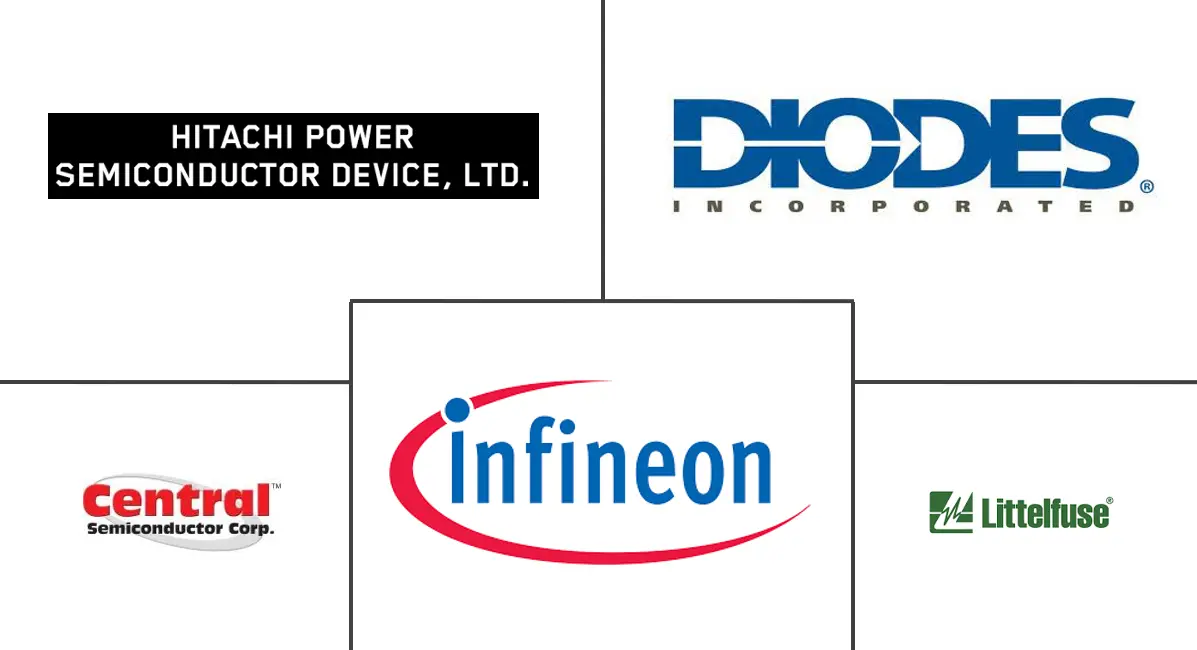Japan Semiconductor Diode Market Size and Share
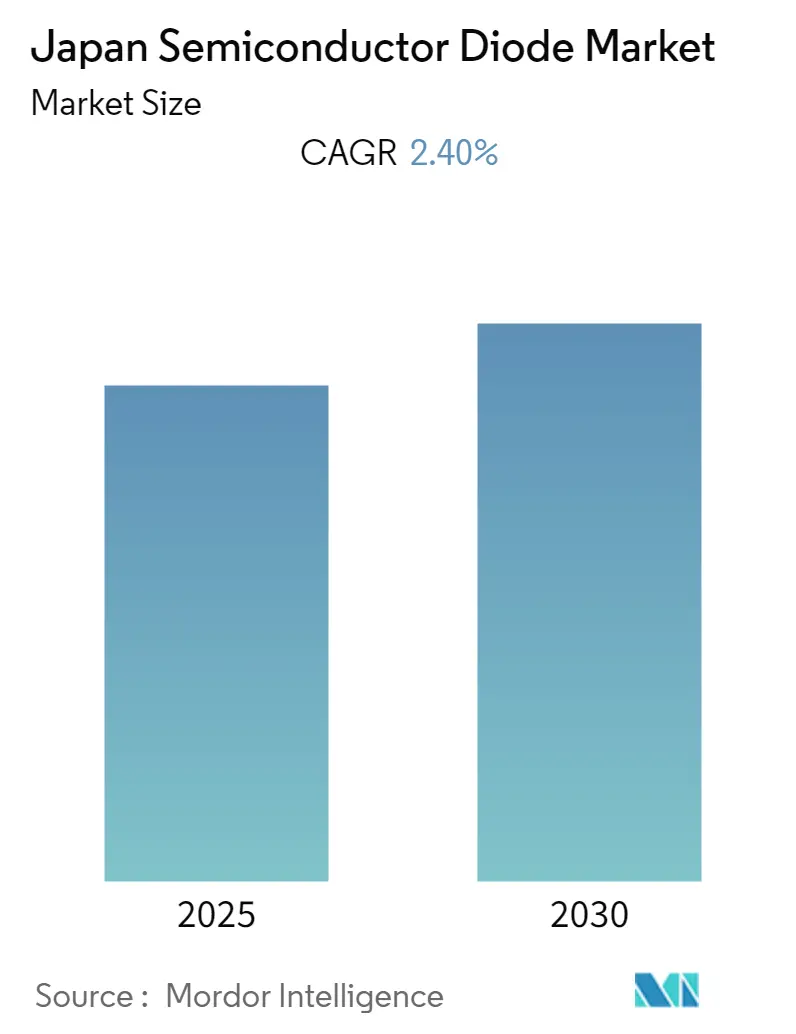
Japan Semiconductor Diode Market Analysis by Mordor Intelligence
The Japan Semiconductor Diode Market is expected to register a CAGR of 2.4% during the forecast period.
The evolution in the performance of laser diode and the changes in its price are expected to drive the market. Technological advancements have enabled lasers to evolve from being technical instruments to being used in a diverse range of applications in the market. The laser diode is the most widely available laser technology, with simple semiconductor devices. As the average power of laser diodes has increased significantly, their average price per watt has decreased exponentially, making them a cost-effective option for various applications. Material processing and optical sensing are examples of the rapidly evolving segments in the market for laser diodes, with many emerging applications.
- However, technological advancements and intensified pricing competition have led to a decline in the market share of existing products and delays in developing new products for next-generation communications, making it difficult to secure the expected revenue. For instance, Renesas Electronics Corporation withdrew from the LD (laser diode) and PD (photodiode/detector) businesses and closed the production line at the Shiga Factory, which manufactured compound semiconductor products.
- Today, Japan is developing new and innovative LED lamps in the market to support the adoption of sustainable and environment-friendly LED lamps. For instance, the Natural Science Center for Basic Research and Development research team from Hiroshima University published their findings on January 28, 2022, in the American Chemical Society Journal ACS Sustainable Chemistry & Engineering.
- Moreover, with the growing commercial and residential infrastructure, retails, hospitals, and public places, various local authorities have undertaken multiple initiatives to beautify the city using LED lamps to promote the adoption of LED lamps in the country.
- For instance, in August 2022, in Japan, a colorful illumination themed on the Milky Way galaxy, dotted with traditional Japanese umbrellas, was organized at the "Nabanano Sato" tourist facility in Kuwana, Mie Prefecture. The "Summer Illumination" spectacle mesmerized visitors as LED light bulbs portrayed stars making up the approximately 130-meter-long, 8-meter-wide "Milky Way" across a large pond at the facility after dusk.
- Further, in June 2022, OSRAM announced that Taiwan-based Ledtech chose the high-performance OSLON UV 3636 UV-C LEDs to provide a sanitization function in its new BioLED intelligent air purifier. The OSLON UV-C LEDs from OSRAM offer a compact, dependable, and more environmentally friendly option to the conventional lamps that produce UV-C at a reasonable price.
Japan Semiconductor Diode Market Trends and Insights
LED is Expected to Hold Significant Market Share
- Energy demand is rising thanks to rapid urbanization and industrialization. Considerable opportunities exist to avoid locking in carbon-based energy technologies for the long term. Alongside its vast renewable energy potential, Japan already possesses significant knowledge and expertise in renewables. Illumination is one of the most fundamental driving forces toward development, facilitating trade, connectivity, safety, and education in a nation. To use energy more efficiently, Japan is undertaking LED revolution initiatives.
- The government in the country is becoming increasingly concerned about energy efficiency in the power sector. This is because the power sector is a significant contributor to greenhouse gas emissions that are responsible for causing climate change and other environmental problems. One of the main ways governments are addressing energy efficiency in the power sector is by encouraging the use of energy-efficient technologies and practices in the power sector, such as energy-efficient lighting systems.
- The growing need for highly efficient lighting systems with a minimum maintenance cost, ease in availability of LED lamps in various color lighting combinations, the increased average lifespan of LED lamps compared to conventional lamps, and its growing integration across multiple end-user segments is likely to drive its growth in the market. This is because, compared with fluorescent lighting technologies, LED lighting systems are much easier to integrate with smart controls to create intelligent and responsive living environments in homes, offices, and cities.
- In April 2022, Signify and DHL Supply Chain designed and implemented a smart lighting solution designed for warehouses. The companies piloted Signify's Interact Industry-connected lighting systems and managed services at a DHL Supply Chain Technology Sector site. Through the partnership, the company replaced DHL's traditional fluorescent T5 lamps with around 800 Day-Brite CFI FBY energy-efficient LED high-bay luminaires.
- Furthermore, in November 2022, Signify expanded its Smart Wi-Fi lighting range by launching two new portable smart lamps: Philips Smart LED Squire and Philips Smart LED Hero. The portable table lamps can be remotely operated from anywhere using the Philips WiZapp or through voice control. The lamps are also compatible with all smart home systems that work with the help of existing Wi-Fi networks.
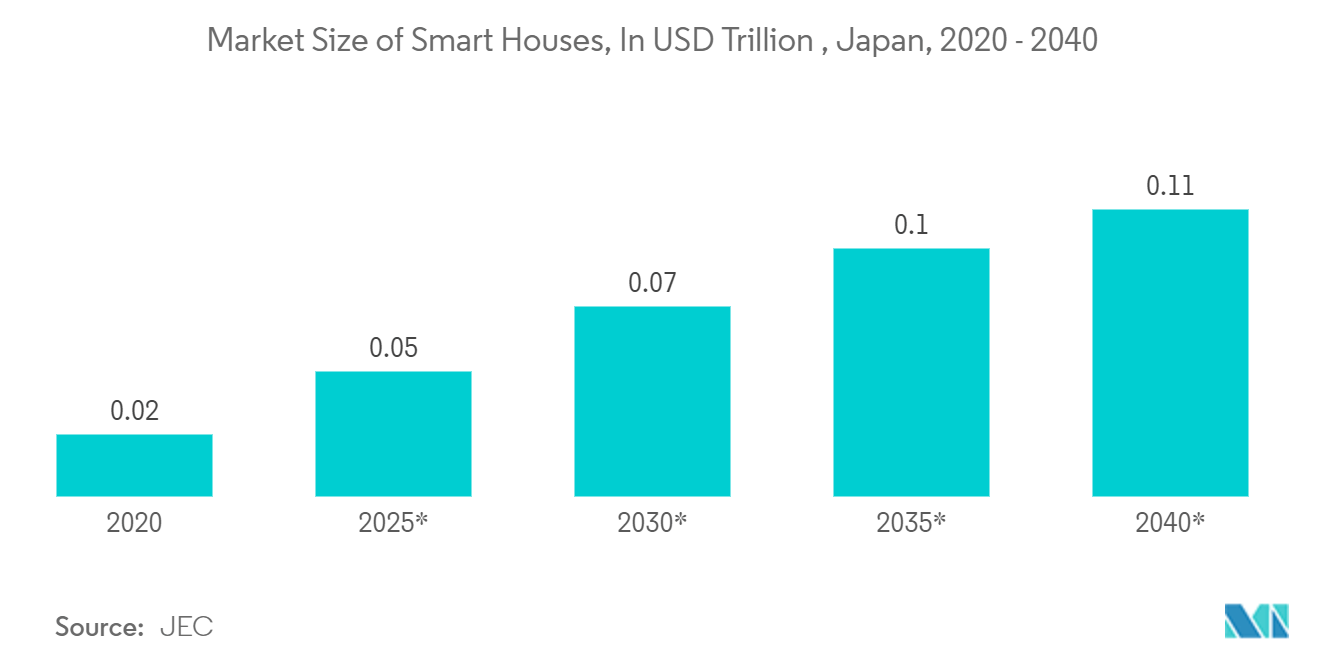
Automotive is Expected to Drive the Market
- LED lights are also widely used as tail lamps for vehicles since they illuminate 0.2 seconds faster than incandescent lights and can help prevent an accident in the case of a sudden stop. The color exhibited by LED lights is also very beneficial to the driver. Unlike incandescent lights, LED lights emit more noticeable and vibrant colors, which, coupled with their quickness in being illuminated, helps ensure driver safety on the road.
- Moreover, LED lights offer better performance, are lighter, save space, and have many other benefits. Beyond just headlights and taillights, these lights are now making their way onto dashboards and rearview mirrors too. Also, the different stringent government rules around the country regarding using high-performance automotive lights create a positive growth outlook for the market.
- LiDAR has emerged as a critical 3D sensing technology, enabling autonomous driving systems and Advanced Driver Assistance Systems (ADAS). Pulsed laser diodes are used in amplitude-modulated LiDAR systems for automotive applications. Frequency-modulated continuous wave (FMCW) LiDAR is an emerging technology trend encompassing CW laser diodes and radar signal processing methods that deliver accurate information on object distance and velocity.
- Therefore, automotive LiDAR shipments are expected to increase considerably in the future. Compared to traditional ADAS sensors, LiDARs are less likely to provide missed or false alerts, making them much safer. According to Goldman Sachs, among all automobile component technologies, such as HMI, LiDAR, radar, cameras, V2X, mapping, embedded controls, etc., LiDAR is expected to offer the highest potential for automotive suppliers.
- Further, adopting laser diodes in the automotive environment involves satisfying high operation requirements from automotive manufacturers. For example, headlights incorporated with laser diodes must work at -40 to +80 degrees. They also need to prove their resistance to strong vibrations and high humidity. Such requirements are being addressed with the advancement of technology.
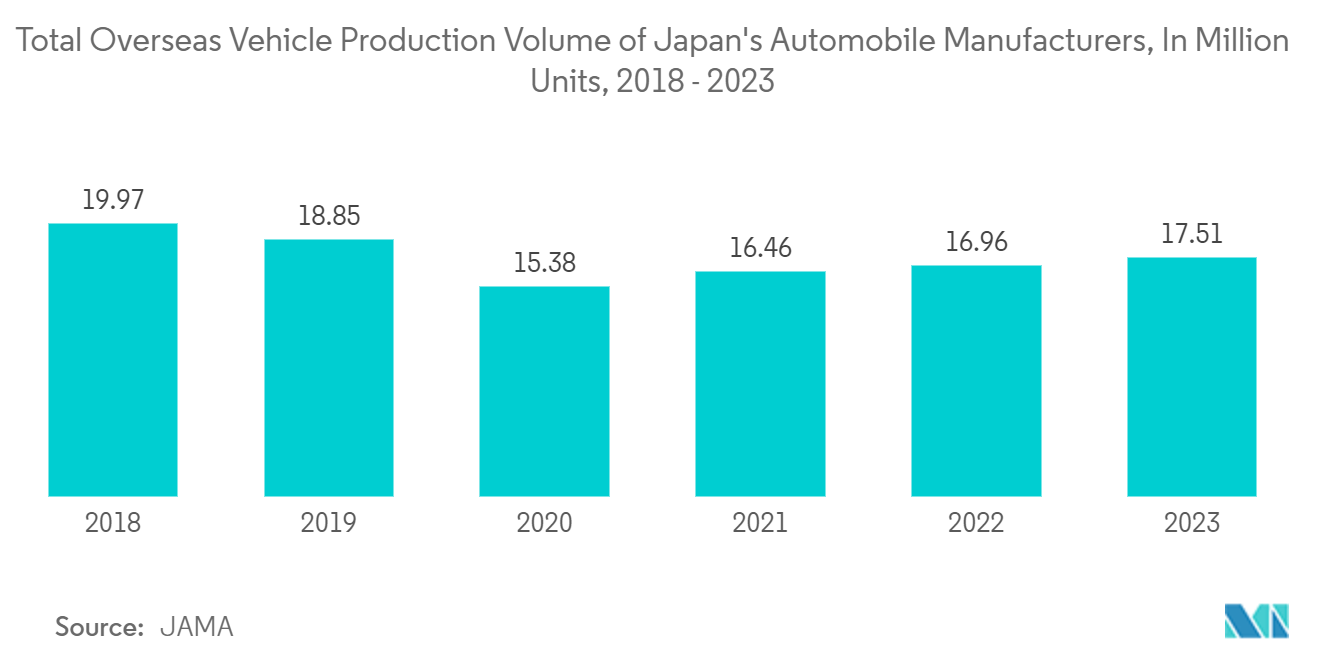
Competitive Landscape
The Japanese semiconductor diode market is fragmented and is expected to grow in competition during the forecast period owing to the entry of several MNCs. The vendors are focusing on developing customized solution portfolios to fulfill local requirements. Some of the major players operating in the market include Central Semiconductor Corporation, Diodes Incorporated, Hitachi Power Semiconductor Device Ltd, Infineon Technologies AG, Littelfuse Inc., MACOM Technology Solutions, NXP Semiconductors NV, ON Semiconductor Corporation, Renesas Electronics Corporation, Rohm Semiconductor, Semtech Corporation, Vishay Intertechnology Inc., etc.
- January 2023 - Nichia Corporation announced the additions of the NVSW719AC and NVSW219C-V2 to its industry-standard ceramic, high-power 3535-size portfolio of LEDs. With state-of-the-art technology, the NVSW719AC is an entirely new LED that expands the possibility of lighting design, while the NVSW219C-V2 delivers unparalleled color uniformity via a dome-less structure.
- May 2022 - OMRON Corporation announced the release of a new high-voltage DC relay, "G9KB," for high-capacity household electricity storage systems globally on May 11, 2022. G9KB safely reduces the direct current in household storage systems with increased capacity. Moreover, G9KB plays a role in encouraging renewable energy by downsizing products.
Japan Semiconductor Diode Industry Leaders
-
Central Semiconductor Corporation
-
Diodes Incorporated
-
Hitachi Power Semiconductor Device Ltd.
-
Infineon Technologies AG
-
Littelfuse Inc.
- *Disclaimer: Major Players sorted in no particular order
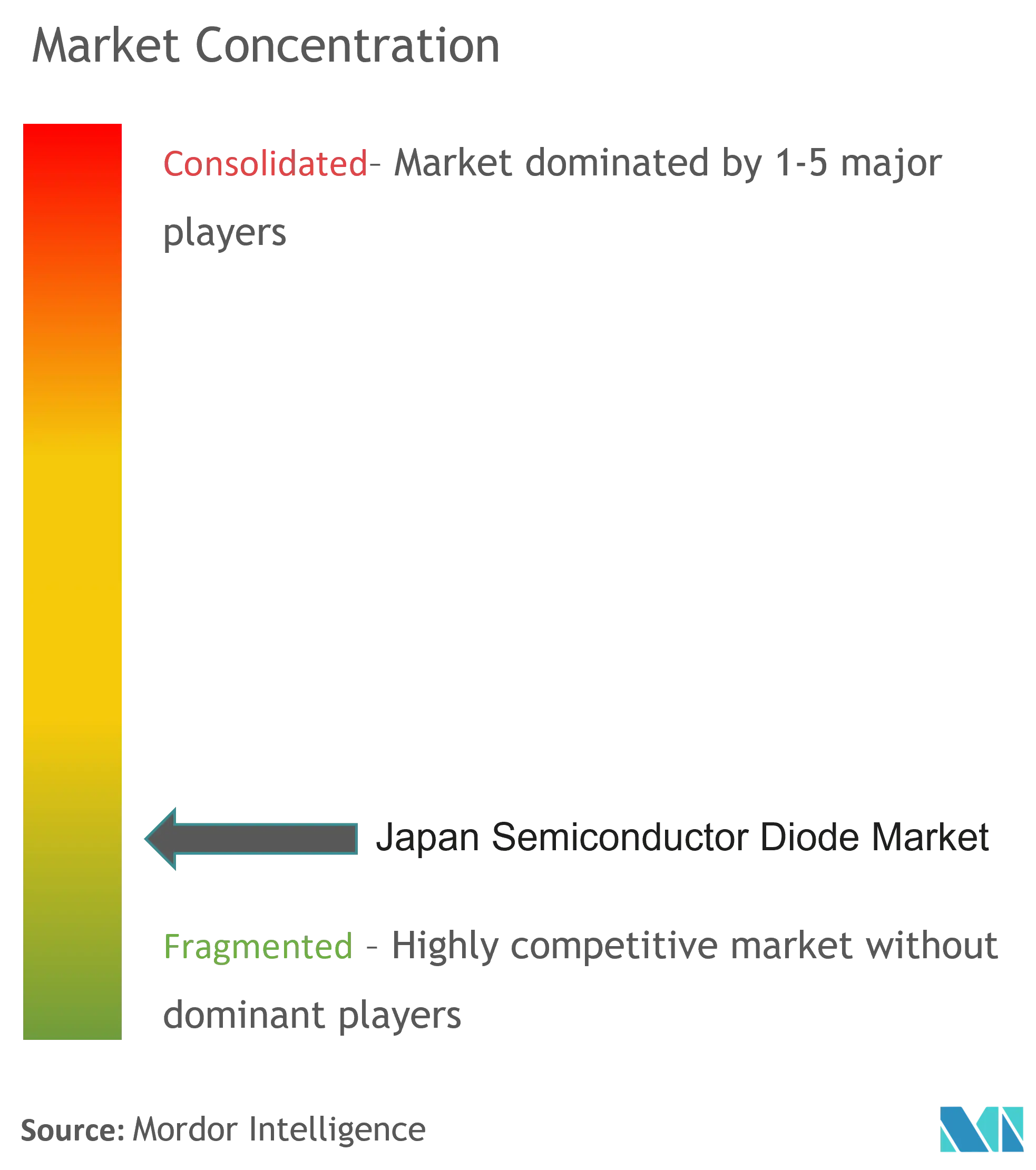
Recent Industry Developments
- January 2023 - Nichia Corporation and Infineon Technologies AG announced the launch of the industry's first fully integrated micro-LED light engine for high-definition (HD) adaptive driving beam applications. The µPLS light engine uses Nichia's unique in-house LED chip, micro-LED technology, and an integrated LED driver IC from Infineon to drive all 16,384 micro-LEDs individually using pulse-width modulation (PWM) control.
- May 2022 - OSRAM released the OSRAM LED Guardian TRUCK FLARE Signal. The TRUCK FLARE, which has an amber flashing light function and an uninterrupted running time of at least 15 hours, can be used as a warning light. In contrast to a warning triangle's basic reflection, an LED warning light is visible from a significant distance. It can actively flash to alert vehicles to a hazardous situation on the road.
Japan Semiconductor Diode Market Report Scope
A diode is an electronic component with ideally zero resistance to current in one direction compared to ideally infinite resistance in the other. A diode acts as a valve with different applications depending on the property or type of diode used in the circuit.
The Japanese semiconductor diode market is segmented by type (zener diode, schottky diode, laser diode, light emitting diode, small signal diode, and other types) and end-user industry (communications, consumer electronics, automotive, computer & computer peripherals, and other end-user industries). The market sizes and forecasts are provided in terms of value (USD) for all the above segments.
| Zener Diode |
| Schottky Diode |
| Laser Diode |
| Light Emitting Diode |
| Small Signal Diode |
| Other types |
| Communications |
| Consumer Electronics |
| Automotive |
| Computer and Computer Peripherals |
| Other End-user Industries |
| By Type | Zener Diode |
| Schottky Diode | |
| Laser Diode | |
| Light Emitting Diode | |
| Small Signal Diode | |
| Other types | |
| By End-user Industry | Communications |
| Consumer Electronics | |
| Automotive | |
| Computer and Computer Peripherals | |
| Other End-user Industries |
Key Questions Answered in the Report
What is the current Japan Semiconductor Diode Market size?
The Japan Semiconductor Diode Market is projected to register a CAGR of 2.40% during the forecast period (2025-2030)
Who are the key players in Japan Semiconductor Diode Market?
Central Semiconductor Corporation, Diodes Incorporated, Hitachi Power Semiconductor Device Ltd., Infineon Technologies AG and Littelfuse Inc. are the major companies operating in the Japan Semiconductor Diode Market.
What years does this Japan Semiconductor Diode Market cover?
The report covers the Japan Semiconductor Diode Market historical market size for years: 2019, 2020, 2021, 2022, 2023 and 2024. The report also forecasts the Japan Semiconductor Diode Market size for years: 2025, 2026, 2027, 2028, 2029 and 2030.
Page last updated on:
Japan Semiconductor Diode Market Report
Statistics for the 2025 Japan Semiconductor Diode market share, size and revenue growth rate, created by Mordor Intelligence™ Industry Reports. Japan Semiconductor Diode analysis includes a market forecast outlook for 2025 to 2030 and historical overview. Get a sample of this industry analysis as a free report PDF download.
